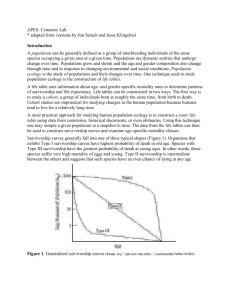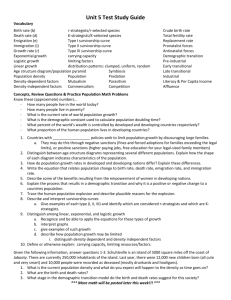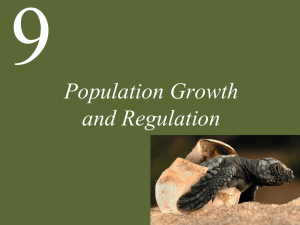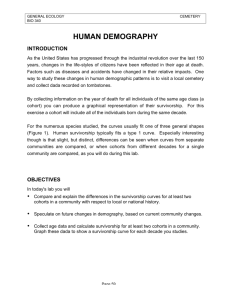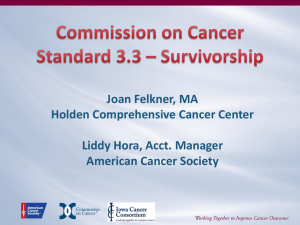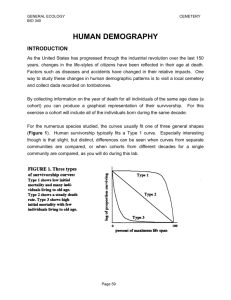General Biology
advertisement
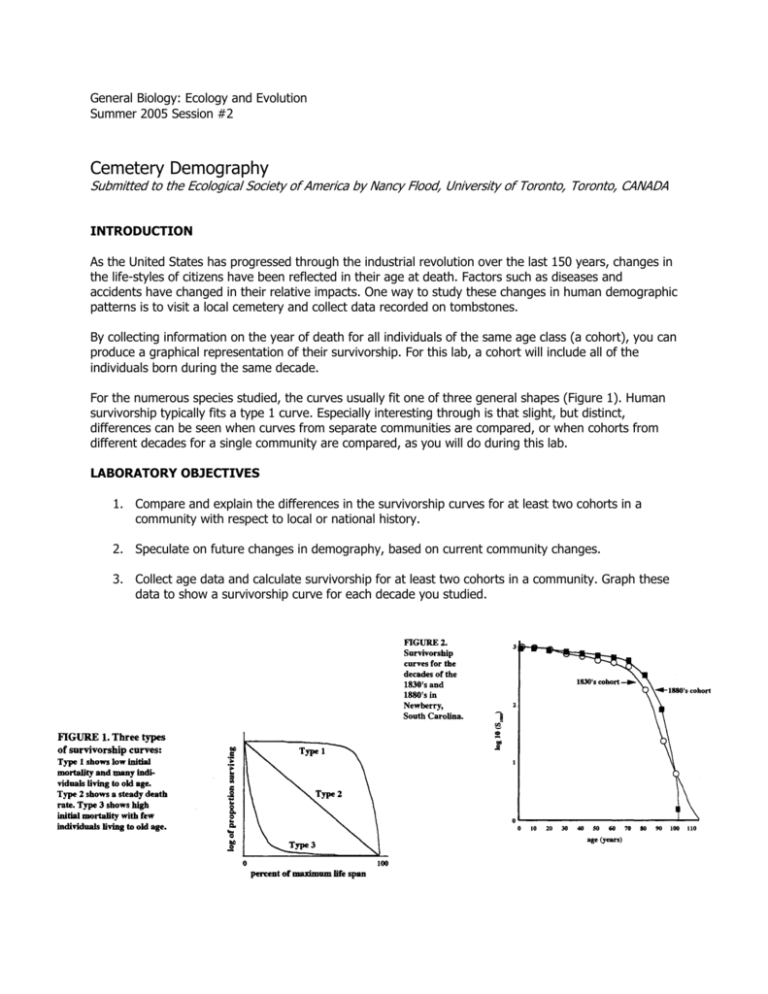
General Biology: Ecology and Evolution Summer 2005 Session #2 Cemetery Demography Submitted to the Ecological Society of America by Nancy Flood, University of Toronto, Toronto, CANADA INTRODUCTION As the United States has progressed through the industrial revolution over the last 150 years, changes in the life-styles of citizens have been reflected in their age at death. Factors such as diseases and accidents have changed in their relative impacts. One way to study these changes in human demographic patterns is to visit a local cemetery and collect data recorded on tombstones. By collecting information on the year of death for all individuals of the same age class (a cohort), you can produce a graphical representation of their survivorship. For this lab, a cohort will include all of the individuals born during the same decade. For the numerous species studied, the curves usually fit one of three general shapes (Figure 1). Human survivorship typically fits a type 1 curve. Especially interesting through is that slight, but distinct, differences can be seen when curves from separate communities are compared, or when cohorts from different decades for a single community are compared, as you will do during this lab. LABORATORY OBJECTIVES 1. Compare and explain the differences in the survivorship curves for at least two cohorts in a community with respect to local or national history. 2. Speculate on future changes in demography, based on current community changes. 3. Collect age data and calculate survivorship for at least two cohorts in a community. Graph these data to show a survivorship curve for each decade you studied. MATERIALS AND METHODS (Do this prior to class on Tu Aug 9th and bring data to class) 1. Select at least two specific cohorts (defined as a decade for this study) in a cemetery in your community. Because you will be following all individuals born during these decades, you must choose two that date prior to the 1900's because there are still individuals alive from dates past this. 2. Record birth year and death year for each individual in Table 1. You need data for AT LEAST 100 individuals. When possible from the information on the headstone, distinguish between males and females. DATA ANALYSIS 1. For each individual calculate the age at death (Table 1). 2. Summarize the data in Table 2. Note data are clustered into age classes (first column) of ten year intervals. For the 0-9 age class, count all of the individuals who died at an age of 9 or less. Continue to record the number of deaths for each of the age classes. The number of deaths for an age class is commonly abbreviated as "dx." When you reach the bottom of the column, determine the total number of deaths and record this number in the indicated space. This number should equal the total number of tombstones you counted for that decade. 3. The third column is for survivorship data (lx) and the calculations of these data are cumulative. Begin by placing a zero (0) in the lowest box of the column. To determine the number for the next box up add to the zero the number for the number of deaths (dx) that appears in the column to the left and one row up. Continue this process of adding on the number to the left and one row up to determine the data for each row of the suvivorship column. When you reach the top you should have the total number of tombstones that you originally counted. (See Table 3 for an example of data determined in this manner.) 4. Standardize the survivorship data to per 1000 (S1000) to allow you to compare data from the two decades. Use the equation below to make the necessary calculations. survivorship per 1000 = total tombstones counted x 1000 To check your calculations for correctness, the top line should be 1000 and the bottom line zero. 5. To standardize your data for graphing, calculate the logarithm to the base ten (10) of each number in the "survivorship per 1000" column. Once again to check your calculations, the number in the top row should be 3 and bottom line will produce an error (log 0 is undefined) on your calculator. For this number just put "0". 6. Plot your data with the x-axis representing time and the y-axis representing the log of the proportion of individuals surviving. Use graph paper or the space provided following Table 2 Compare your data with Figures 1 and 2. QUESTIONS 1. Do the curves for the different decades differ from one another? If so, what might have caused the differences? 2. How do your graphs compare with Figure 1, survivorship curves for different types of populations and with Figure 2, survivorship curves for Newberry, South Carolina. Can you explain any differences? 3. How would your data have been altered if your cemetery had closed in 1965 rather than being open to the present day? 4. One problem with studying survivorship curves is that a birth cohort must be followed through until the death of the last individual. How would a 1940's survivorship curve be altered from those of the 1800's? 5. Speculate about the future if: a) Aids continues to increase and no cure is found. b) Medical advances continue and most diseases and infant mortality are eliminated. c) Environmental problems get worse and pollution related diseases increase. 6. What type of assumptions did you (and all ecologists) need to make in order to develop the survivorship curves for your town? # OF BIRTH DEATH AGE AT SEX # OF INDIV. YEAR YEAR DEATH INDIV. 1 26 2 27 3 28 4 29 5 30 6 31 7 32 8 33 9 34 10 35 11 36 12 37 13 38 14 39 15 40 16 41 17 42 18 43 19 44 20 45 21 46 22 47 23 48 24 49 25 SEE THE FOLLOWING PAGE FOR INDIVIDUALS #51 -100. BIRTH YEAR DEATH YEAR AGE AT DEATH SEX # OF BIRTH DEATH AGE AT SEX INDIV. YEAR YEAR DEATH 51 52 53 54 55 56 57 58 59 60 61 62 63 64 65 66 67 68 69 70 71 72 73 74 75 SEE THE PREVIOUS PAGE FORINDIVIDUALS # 1-50 # OF INDIV. 76 77 78 79 80 81 82 83 84 85 86 87 88 89 90 91 92 93 94 95 96 97 98 99 100 BIRTH YEAR DEATH YEAR AGE AT DEATH SEX AGE YEARS 0-9 10-19 20-29 30-39 4049 50-59 60-69 70-79 80-89 90-99 100-109 110+ SURVIVORSHIP CLASS #DEATHS IN #SURVIVING FROM BIRTH (lx) PER 1000 (S1000) CLASS (dx) LOG10 (S1000) Table 3: Example of survivorship talbe from a cemetery in Newberry SC, summarizing data for the 1830’s cohort. AGE CLASS #DEATHS IN #SURVIVING SURVIVORSHIP PER LOG10 (S1000) YEARS CLASS (dx) FROM BIRTH (lx) 1000 (S1000) 0-9 8 160 1000 3.00 10-19 7 152 950 2.98 20-29 13 145 906 2.96 30-39 9 132 825 ).g-) 40-49 13 123 769 2.89 50-59 21 110 688 2.84 60-69 23 89 556 2.75 70-79 39 66 413 2.62 80-89 22 27 169 2.23 90-99 4 5 31 1.49 100-109 1 1 6 0.78 110+ 0 0 0 "Oil REFERENCES Condran, G. and E. Crimmins. 1980. Journal of Historical Geography 6 (2): 179-202. Dethlefsen, E. S. and K. Jensen. 1977. Social commentary from the cemetery. Natural History 86(6) 32-39. Gwatkin, D. R. and S. K. Brandel. 1982. Scientific American 246 (5): 57-65, Kuntz. S. 1984. Human Biology 56: 559-582. Mahler, H. 1980. Scientific American 243 (3): 67-77.

